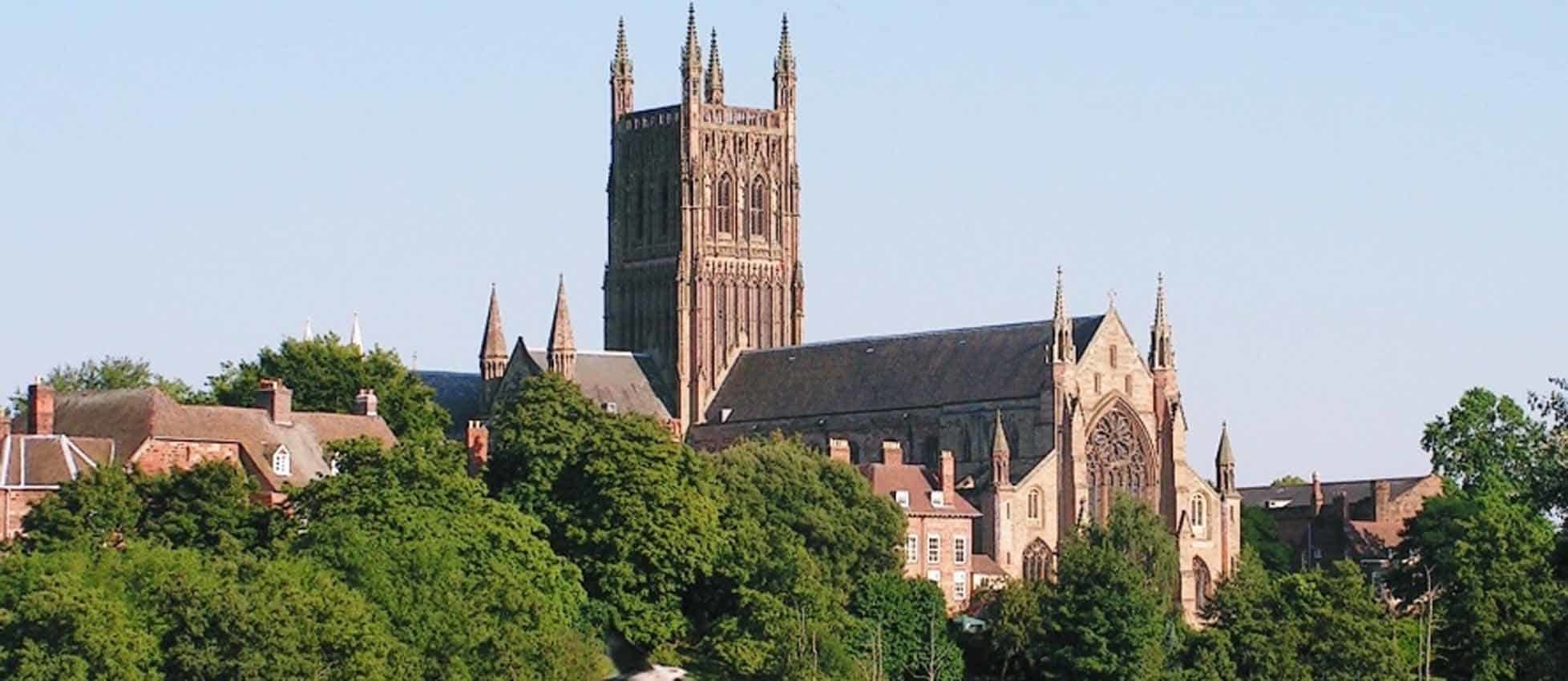


Worcester Cathedral
Worcester Cathedral is a magnificent sight as it rises majestically above the River Severn. Worcester has been the seat of a bishopric since the Seventh Century, and the Cathedral was served by monks until the Reformation. St Oswald and St Wulfstan were among the bishops.
It has been a place of Christian worship and prayer for fourteen centuries. The present building was begun in 1084 and is dedicated to Christ and the Blessed Virgin Mary.
The cathedral was founded in 680. During Anglo-Saxon times, Worcester was one of the most important monastic cathedrals in the country and was home to a community of Benedictine monks.
Reminders of this monastic life can still be seen: in various ruins around the Cathedral grounds; and also in the Cloisters, Garth Garden, stalls in the quire, and Chapter House which are still in use today.
Worcester was a great centre for learning and some of the texts produced by the monks can still be seen in the Cathedral library today.
It is the mother church of the Diocese of Worcester and for centuries, worshippers and visitors have made the journey to Worcester Cathedral to gain inspiration and knowledge and to experience this very special place.
Since the Eighteenth Century, the Cathedral has been famous for its part in the annual Three Choirs Festival, the oldest choral festival in existence.
Today the Cathedral is the centre of a vibrant community of clergy and laypeople, offering the praises of God each day, serving the city and diocese of Worcester, and attracting visitors from all over the world.
There is plenty on offer for families with activities and events throughout the year, trails, special services and daily tours. The cosy Cloister Cafe is the Cathedral’s on-site café, where you’ll find a delicious selection of food, drinks, cakes and ice creams. Meanwhile, The quaint Gift Shop is the perfect place to pick up a unique souvenir for a loved one.
The west elevation of the Cathedral is an iconic image, regularly communicated worldwide through television coverage of the matches at Worcestershire County Cricket ground to evoke a quintessentially English vista.
The Diocese of Worcester was created in 680. Bishop Oswald (961) founded a Benedictine monastic community attached to its Cathedral. Bishop Wulfstan (1062) survived the Norman conquest and began rebuilding the Cathedral in 1084. King John was among its later benefactors and asked to be buried within it.
Prince Arthur, eldest son of Henry VII, is also buried in the Cathedral. However when his brother, Henry VIII, dissolved the monasteries, the shrines of Oswald and Wulfstan were destroyed and the Cathedral was re-founded with the constitution of a Dean and Chapter.
The Cathedral suffered further damage during the Civil War. It was extensively restored during Victoria’s reign and a recent major project of restoration, started in 1988 was completed in 2011.
Today the Cathedral is one of the major tourist attractions in the City of Worcester and across the county. It attracts approximately 200,000 visitors each year and plays a central role in the culture and tourism of the City.
Its attractions include King John’s Tomb, Prince Arthur Tudor’s Chantry Chapel, magnificent Victorian stained-glass windows, St Wulfstan’s Norman Crypt, a 12th century Chapter House, thought to be the first round Chapter House in the world, Medieval Cloisters, stunning views across the beautiful Worcestershire countryside for the top of the tower, and examples of every period of early English architecture from 11th to late 14th Century.
The Cathedral is open daily, with free entry, and donations welcomed, and hosts a packed and varied programme of services and events throughout the year.
We look forward to welcoming you to this magnificent Cathedral in the heart of Worcestershire!
Watch our live peregrine webcam here.
Latest news from Worcester Cathedral
Updated – Cathedral Peregrine Webcams
As we enter the 2024 nesting season for Peregrine falcons – here is an update on all the
International Organ Day – 20th April
Did someone say Silent Discos? This summer it’s all about the organ! International Organ Day
Are you ready? It’s Peregrine Season
Worcester Cathedral has launched its Peregrine Falcon livestream on YouTube as the birds return
Royal Maundy Service comes to Worcester Cathedral
The annual Royal Maundy Service will come to Worcester Cathedral this year when Her Majesty The
Wolfson Foundation Grant for Worcester Cathedral
Worcester Cathedral is celebrating scooping a £200,000 grant from the Wolfson Foundation
Contact cathedral
Worcester Cathedral
College Yard
Worcester
WR1 2LA
01905 732900
Email the cathedral Visit the website